The Radeon HD 4850 & 4870: AMD Wins at $199 and $299
by Anand Lal Shimpi & Derek Wilson on June 25, 2008 12:00 AM EST- Posted in
- GPUs
Building a RV770
We did this with NVIDIA's GT200 and it seemed to work out well, so let's start at the most basic level with AMD's RV770. Meet the Stream Processing Unit:
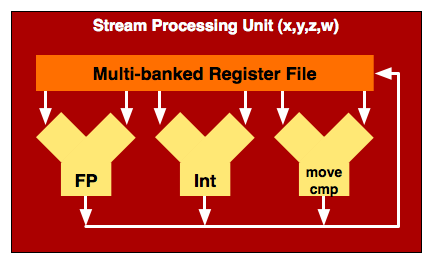
AMD's Stream Processing Unit is very similar to NVIDIA's SP in G80/G92/GT200, so similar in fact that I drew them the same way. Keep in mind that the actual inner workings of one of these units is far more complex than three ALUs but to keep things simple and consistent that's how I drew it (the actual hardware is a fused FP MUL + ADD unit, for those who care). AMD has four of these stream processing units in a processor block and they are called x, y, z or w units.
There's a fifth unit called a t-unit (the t stands for transcendental, meaning the type of operations it is capable of processing):

The t-unit can do everything a x,y,z or w-unit can do, but it also can do transcendental operations (represented by the SFU block in the diagram above). NVIDIA has the same functionality, it simply chooses to expose it in a different way (which we'll get to shortly). AMD considers each one of these units (x,y,z,w and t) a processing unit, and the RV770 has 800 of them (the RV670 had 320).
AMD pairs four of these stream processing units (x,y,z and w) with a t-unit and puts them together as a block, which I have decided to call a Streaming Processor (SP):

The area in red is actually the SP, but unlike one of NVIDIA's SPs, one of AMD's can handle up to five instructions at the same time. The only restriction here is that all five units have to be working on the same thread.
AMD then groups 16 of these SPs into something they like to call a SIMD core (AMD has less confusing, but far worse names for its architectural elements than NVIDIA):
|
AMD's SIMD Core
|
NVIDIA's SM
|
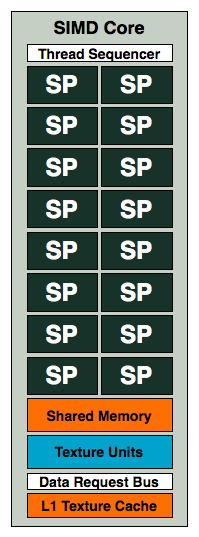 |
 |
A SIMD core is very similar to NVIDIA's SM with a couple of exceptions:
1) There are more SPs in AMD's SIMD Core (16 vs 8)
2) The SPs are wider and can process, at peak, 5x the number of instructions as NVIDIA's SPs
3) The Instruction and Constant caches are not included in the SIMD core, AMD places them further up the ladder.
4) AMD pairs its texture units and texture cache with its SPs at the SIMD core level, while NVIDIA does it further up the ladder.
5) See the two SFUs in NVIDIA's SM? While NVIDIA has two very fast Special Function Units in its SM, AMD equips each SP with its own SFU. It's unclear which approach is actually faster given that we don't know the instruction latency or throughput of either SFU.
Note that at this point, the RV770 is really no different than the RV670 (the GPU used in the Radeon HD 3870). The next step is where AMD and NVIDIA really diverge; while NVIDIA's GT200 takes three SMs and groups them into a Texture/Processing Cluster (TPC) and then arranging 10 TPCs on its chip, AMD simply combines 10 SIMD cores:

AMD's RV670
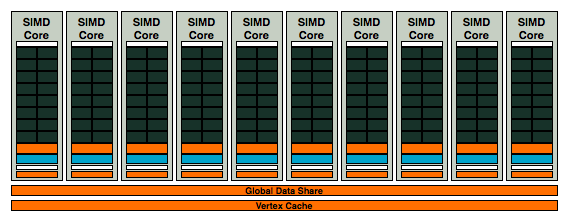
10 SIMD cores at your disposal in AMD's RV770, this is how AMD goes from competitive, to downright threatening
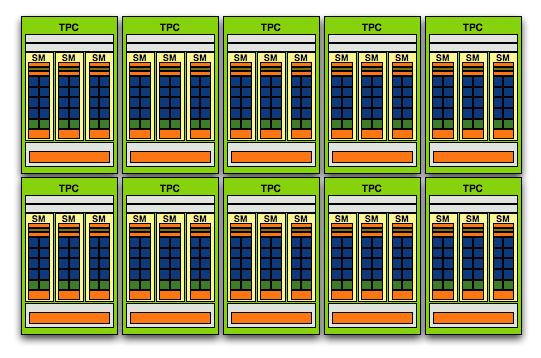
NVIDIA's GT200 Streaming Processor Array (SPA), it has fewer execution resources but more encapsulation around them, the focus here is on thread management
With 10 SIMD cores the RV770, it has 2.5x the number of execution units as a RV670. It even has more theoretical processing power than NVIDIA's GT200. If you just look at the number of concurrent instructions that can be processed on RV770 vs. GT200, the RV770's 800 execution units to GT200's 240 (+ 60 SFUs) is in a completely different league.
| NVIDIA GT200 | AMD RV770 | AMD RV670 | |
| SP Issue Width | 1-way | 5-way | 5-way |
| # of SPs | 240 | 160 | 64 |
| Worst Case Dependent Instruction Throughput | 240 | 160 | 64 |
| Maximum Scalar Instruction Throughput | 480* | 800 | 320 |
We'll be talking about efficiency and resource utilization in the coming pages, but immediately you'll notice that the RV770 (like the RV670 and R600 that came before it) has the potential to be slower than NVIDIA's architectures or significantly faster, depending entirely on how instruction or thread heavy the workload is. NVIDIA's architecture prefers tons of simple threads (one thread per SP) while AMD's architecture wants instruction heavy threads (since it can work on five instructions from a single thread at once).
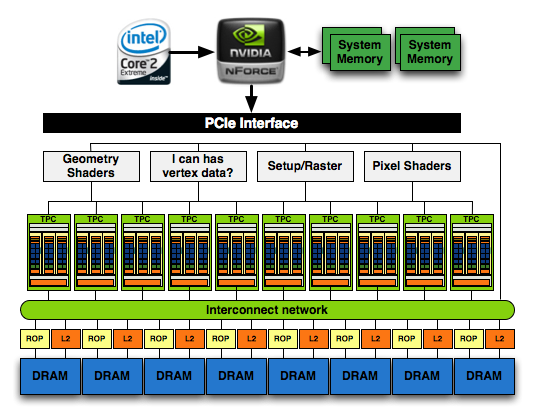
NVIDIA's GeForce GTX 280
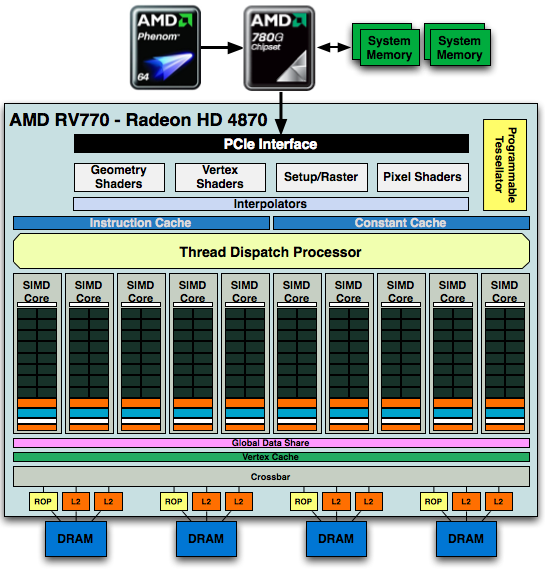
AMD's Radeon HD 4870
The full GPU is pretty impressive:
1) See the Instruction and Constant Caches up top? NVIDIA includes them in each SM while AMD seems to include them outside of the SIMD core clusters.
2) The RV770 only has four 64-bit memory controllers compared to the eight in GT200
3) The Programmable Tessellator is left over from the Xbox 360's GPU (and R600/RV670), unfortunately it is unused by most developers as there is no DirectX support for it yet.
4) AMD has dedicated hardware attribute interpolators, something NVIDIA's hardware shares with its special function units (SFUs).
Other than the differences we mentioned above, AMD's architecture is similar in vain to NVIDIA's, there are just a handful of design choices that set the two apart. Just like NVIDIA took its G80/G92 architecture and made it larger, AMD did the same with RV770 - it took RV670 and more than doubled its execution resources.
AMD took a bigger leap with RV770 from RV670 than NVIDIA did from G80/G92 to GT200, but it makes sense given that AMD had to be more competitive than it even was in the last generation.










215 Comments
View All Comments
0g1 - Wednesday, June 25, 2008 - link
In the article it says the GT200 doesn't need to do ILP. It only has 10 threads. Each of those threads needs ILP for each of the SP's. The problem with AMD's approach is each SP has 5 units and is aimed directly at processing x,y,z,w matrix style operations. Doing purely scalar operations on AMD's SP's would be only using 1 out of the 5 units. So, if you want to get the most out of AMD's shaders, you should be doing vector calculations.DerekWilson - Wednesday, June 25, 2008 - link
The GT200 doesn't worry with ILP at all.a single thread doesn't run width wise across all execution units. instead different threads execute the exact same single scalar op on their own unique bit of data (there is only one program counter per SM for a context). this is all TLP (thread level parallelism) and not ILP.
AMD's compiler can pack multiple scalar ops into a 5-wide VLIW operation.
on purely scalar code with many independent ops in a long program, AMD can fill all their units and get close to peak performance. explicit vector instructions are not necessary.
gigahertz20 - Wednesday, June 25, 2008 - link
http://www.hardwarecanucks.com/forum/hardware-canu...">http://www.hardwarecanucks.com/forum/ha...870-512m...The site above mounted an after market cooler on it and got awesome results. Either the Thermalright HR-03 GT is just that great of a GPU cooler, or the standard heatsink/fan on the 4870 is just that horrible. Going from 82C to 43C at load and 55C to 33C at idle, just from an after market cooler is crazy! I was hoping to see some overclocking scores after they mounted the Thermalright on it, but nope :(
Matt Campbell - Wednesday, June 25, 2008 - link
The HR-03GT really is that great. Check it out: http://www.anandtech.com/casecoolingpsus/showdoc.a...">http://www.anandtech.com/casecoolingpsus/showdoc.a...Our 8800GT went from 81 deg. C to 38 deg. C at load, 52 to 32 at idle. That's also with the quietest fan on the market at low speed. And FWIW, I played through all of The Witcher (about 60 hours) with the 8800GT passively cooled in a case with only 1 120mm fan.
-Matt
Clauzii - Wednesday, June 25, 2008 - link
I see no fan on that thing??! PASSIVE?? :O ??jeffreybt2 - Wednesday, June 25, 2008 - link
"Please note that this is with a single Zalman 92MM fan operating at 1600RPM along with Arctic Cooling MX-2 applied to the base."magnusr - Wednesday, June 25, 2008 - link
Does the audio part of the card support PAP? If not all blu-ray audio will be downsampled to 16/48...NullSubroutine - Wednesday, June 25, 2008 - link
I would just like to point out that the 4870 falls behind the 3870 X2 in Oblivion while in every other game it runs circles around it. To me it appears to be a driver problem with Oblivion rather than an indication of the hardware not doing well there. Unless of course the answer lies in the ring bus of the R680?orionmgomg - Wednesday, June 25, 2008 - link
I would love to see more benchmarks with the CPU OCed to at least 4.0All the CPUs you use can hit it NP.
Also, what about at least 2 GTX 280 Cards and their numbers. Noticed that you did have them in SLI cause the power comsumption comparisons had them, but you held back the performance numbers...
Lets see the top 4 cards from ATI and Nvidia compete in dule GPU (no punt intended)on an X48 with DDR3 1600 and a FSB of 400x10!
That would be really nice for the people hoe have performance systems, but may still be rocking out a pair of EVGA 8800Ultras, cause their waiting for real numbers and performance to come out - and their still paying off theye systems lol... :]
Ilmarin - Wednesday, June 25, 2008 - link
You're probably aware of these already, but I'll mention them just in case:* Page 10 (AA comparison) is malformed with no images
* Page 21 (Power, Heat and Noise) is missing the Heat and Noise stuff.
Heat is a big issue with these 4800 cards and their reference coolers, so it would be good to see it covered in detail. My 7800 GTX used to artifact and cause crashes when it hit 79 degrees, before I replaced it with an aftermarket cooler. Apparently the 4870 hits well over 90 degrees at load, and the 4850 isn't much better. Decent aftermarket coolers (HR-03 GT, DuOrb) aren't cheap... and if that's what it takes to prevent heat problems on these cards, some people might consider buying a slower card (like a 9800 GTX+) just because it has better cooling.
Anand, you guys should do a meltdown test... pit the 9800 GTX+ against the 4850, and the 4870 against the GTX 260, all with reference coolers, in a standard air-cooled system at a typical ambient temp. Forget timedemos/benchmarks... play an intensive game like Crysis for an hour or two, and see if you encounter glitches and crashes. If the 4800 cards can somehow remain artifact/crash free at those high temps, then I'd more seriously consider buying one. Heat damage over time may also be a concern, but is hard to test for.
Sure, DAAMIT's partners will eventually put non-reference coolers on some cards, but history tells us that the majority of the market in the first few months will be stock-cooled cards, so this has got be of concern to consumers... especially early adopters.